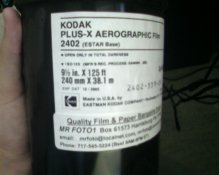I have 2402, so no need to let me know...sounds like you 'violated' the seal anyway :O) .
Yeah, slitting, everyone's headache.
The 2402 is I think 0.004". The 39xx? you originally listed is 0.0025", even worse in a sheet fim holder.
The 2402 data sheet says it has an antihalation dye. I put a piece undeveloped in the sink & ran water on it (I don't know why), and it ran pink/magenta.
Someone suggested that different vintages may not have had the anti-halation layer, but I would think then that it would have to be 1) MUCH older or b) have different enough behavior that it couldn't be considered the same film.
So I tend to not believe the stories about existence of alleged no-halation 2402.
If you look at the data sheet, speed is listed as ISO A. A is for aerial. It's based on different spectral properties of light and camera angle at high altitude. The published film speeds are also based on the higher temperature development in a different soup than we terrestrial photographers use.
I talked to Kodak once on this, and I swear the guy told me to double the aerial ISO to get a 'normal' one, as an approximation. He said there is no simple conversion because the factors are complex and variable.
I think he meant to say HALVE.
I've heard EI as low as 80 (for 2402), but it's like pinning a tail on the donkey with a blindfold (or darkcloth) because the development for most people will be different than spec.
One guy told me it's really grainy...I would wish it was like Plus-X with extended red sensitivity...maybe his experience with grain is due to his random success with development choice.
I found working with it in the dark pretty traumatic too. That was my first darkroom effort in 28-ish years. I sat the spool (5" rollx 1000', not as teetery as yours) in the lid on a clean floor to 'dereel' some. I pulled too hard & it leaped out of the cannister lid and began rolling across the darkroom, with me taking up film in my hands as fast as I could. I intended to send several feet to someone and he got alot more than I intended.
I was also disturbed by sparks (triboelectric?) from removing the tape from the film end (I had never experienced that before with puny tapeless 35mm or 120 film).
For the next effort I built a spool holder with a bolt for an 'axle' that worked fine in daylight, but with the weight of the spool on it, I couldn't get the bolt thru the supports easily.
All very frustrating. I was tempted to go visit a local lab that has night vision goggles, but I don't want to gamble with how far down in the mud the IR response is.
I think a 29 filter would work fine. It's tempting to try some with an 87 and much longer exposure to see what's 'below the graph'.
Photo Engineer said the response cutoff is very drastic but I suppose after wrangling a big spool like that one's earned the right to stubbornly try it anyway. I don't know if that would be considered push or pull or wishful.
When I have a dark place at home it won't be such a rushed and stressful thing to work with. I had to drive across town to a place that let me use their darkroom and I was on a tight schedule.
What did you use for EI and chenistry/time, OPT?
Will you be able to share images?
Thanks
Murray








 .
.






